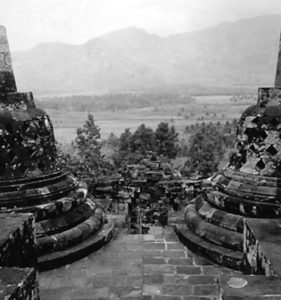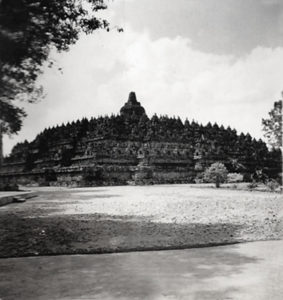Borobudur and the Mystery of Coincidence
This post is about Borobudur, my grandmother, and something magical that manifests from the realm of imagination. The “something magical” is always available to us when we soften our grip and allow the dynamic force of life itself to support our journey.
The photographs you see are of Borobudur, a Buddhist temple in Java that I first read about in a letter my grandmother wrote to her sister in 1930, and is an important part of the story in How Patience Works. The photos are from one of her albums.
My grandmother wrote this about Borobudur:
In the afternoon after we arrived . . . we drove to the Boro Bodoer, about ten miles away. I think you know about that old Buddhist temple, dating back to the ninth century. I had seen it only once, nine years ago. It is remarkable for its form, being built over a mound of rock. There is no inside, just
tiers dug around the outside of the natural mound, paved and walled with rock elaborately carved in pictures representing the life of Buddha in his various incarnations. All uncovered – just sky above.
My grandparents were American, but my grandfather’s job took them to Java where they raised my mother and her brother between 1920 and 1935. My grandmother died at a young age so I never met her, but I grew to know her through reading a box of her letters that was delivered to my home in 1989. An older cousin I barely knew called one day to say he was on his way to a dowsing convention in Vermont and asked if I would like to have the letters she had written to her sister. Of course, I said, “yes.” After a nice visit over lunch, he left the letters and a pair of dowsing rods with me. I never saw or heard from him again. Considering all the years and distance that had grown between our families, I sometimes wonder if he dowsed to find me.
My grandmother’s letters informed the character of Ruth, Mrs. Sternau’s friend and teacher in How Patience Works. When Mrs. Sternau gives Troy instruction on Patience, she follows the tradition before any teaching is given that one must clearly reveal its source. Doing so demonstrates an instruction’s legitimacy by tracing both the teaching and the teacher’s lineage. Ruth’s study began with her mother while they were living in Java. Her mother, inspired by the sense of peace she experienced visiting Borobudur, became a dedicated student of a teacher whose lineage traced back to Atisha (982-1054 CE.) Atisha is not a fictional character. He trained for twelve years in Sumatra before returning to India and then later to Tibet, and is a very important figure in Tibetan Buddhism. My grandmother never studied Buddhism, but like Ruth’s mother she educated her children at home so it seemed very natural for Ruth’s mother to share the dharma with her children.
Writing fiction is clearly an activity of imagination, and imagination is a powerful conduit that nurtures possibilities into being. There have been several “coincidences” specifically associated with my writing. Some more remarkable than others, but they all give me pause when I consider the potential that the inner world of imagination and focus demonstrate through their participation with the outer world. Last fall I attended a book talk given by a friend’s daughter. I had recently completed my final draft of How Patience Works and was waiting for the editor’s revisions. After the presentation, while people were waiting in line to greet the author, I began talking with a man standing behind me. His name is Anton, and I learned that not only had he and his wife lived in Java, but that he was also very familiar with Borobudur. In fact he is a college friend of the grandson of Theo Van Erp, the man who led the reconstruction of Borobudur in 1900 after centuries of it being almost entirely covered by soil, vegetation, and volcanic ash. Anton had translated a chapter about Theo Van Erp’s work in a book on Borobudur, and offered me a copy of the book to read.
A few weeks later Anton and I met for coffee and he looked with great care through my grandmother’s old photographs of Java. He was able to recognize places she had photographed, providing me with more background to the life my grandmother lived. Another coincidence I later recognized is that more than a year before I’d heard of Theo Van Erp, a character I named “Theo” had practically planted himself into How Patience Works.
While I don’t know what the significance of coincidences may or may not be, I believe they’re worth noting. Life has a magical quality when we pay attention to its more subtle confluences, and when we soften our grip to allow for the dynamic force of life itself to support our journey.


Thank you for this post. Coincidences like the ones you noted are always amazing to experience. Coincidences for me serve as a reminder that I am on the right path. I celebrate coincidences when they happen and wish them on everyone.